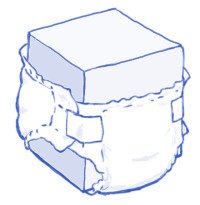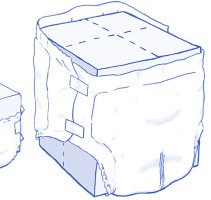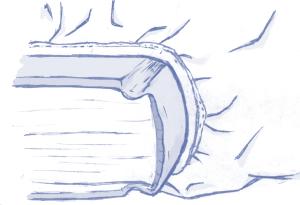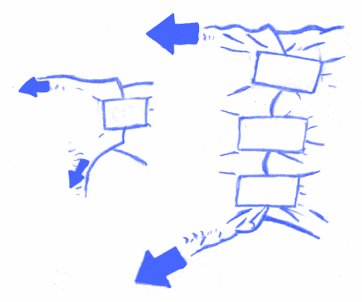> Howto >
Why Big Babies Leak
By BitterGrey
Little tykes have it all. They get to be carried around, cuddled, can take stuffies anywhere, and can fit into off-the-rack baby clothes. They even have physics on their side: Babies are physically less apt to leak. They benefit from surface area, curvature, and shear scale. The unfairness of physics is enough to make an adult baby cry.
Part 1: Surface Area Ratios

To start with, babies have the advantage of surface area. Consider a baby cube. Let's say its a girl cube, one baby cube tall. Each of her six square sides will have a surface area equal to her width times her height. 6x1x1=6. Her diaper will cover some of this surface area. The baby cube will have a volume equal to her width times her height times her depth. 1x1x1=1. Some fraction of this volume would be bladder. The rest of her body will be generating waste to go through the bladder. The baby cube will also be able to be changed in public, but I digress.

In contrast to the baby cube, we have an adult baby cube. (The mathematics would apply equally to a diaper lover cube.) Let's say that the adult baby cube was two baby cubes tall. Each of his six sides would have a surface area equal to his height times his width. 6x2x2=24. That is, it has four times as much surface area as the baby cube. In turn, his volume would be equal to his height cubed. 2x2x2=8. That is, he has eight times as much volume as she does.
Since the adult baby cube has eight times as much volume, he would generate about eight times as much urine. Unfortunately for him, he only has four times as much surface area to wrap a diaper around. Every square inch of diaper has twice as much pee to soak up.
Any urine that isn't instantly absorbed by the diaper runs down towards the leg or waist gathers. Of course, these gathers also work better for babies - because physics is unfair.
Part 2: Curvature
The seals at those gathers are dependent on their curvature. Real babies are pudgy. Their legs and waist are small and round, ideal for good seals. In contrast, adult babies come in a wide range of shapes and sizes. They might be bony, muscular, heavy, etc. As we will see, any shape other than small and round is more leak-prone.

To avoid delving into a detailed discussion of human anatomy, let's consider a simpler shape; a hardcover book. While any hardcover book will do, I've chosen Wilhelm Stekel's "Patterns of Psychosexual Infantilism." While insightful for its day, the differences between psychosexual infantilism and paraphilic infantilism tend to make the book a bit runny; thus the need for plastic pants.
These plastic pants have elastic sewn in the hems, to prevent leaks. When the hem wraps around something, the tension in the elastic theoretically holds the hem closed. However, that something must be round.
For example, consider the section where the back cover connects to the spine of the book. This area is concave, it isn't even touching the hem. No matter how tight the elastic is, the plastic pants won't get a good seal here. Adult babies have similar concave areas next to their own spines. Many an adult baby has slept on his back, only to wake up with a wet T-shirt after his diaper leaked around his spine. (Again, sadly, diaper lovers who wet are also subject to this problem.)
The flat section of the cover is also highly prone to leaks. Even though the hem is touching the book, there isn't any force to hold the seal closed. This is because the cover is flat, not round: There is no curvature.
The only place where the hem can make a good seal is around the curved spine of the book. Here, the book is round, so the hem can force the seal closed. The more round, the better the seal. Mathematically, the seal force is inversely proportional to the radius of curvature. All else being equal, it is highest for small, round things, like babies.
Of course, most plastic pants have a porous hem, such as unwrapped elastic or unsealed stitching, so even a good sealing force won't guarantee a watertight seal.
Getting even a halfway decent seal around the legs and waist of an adult baby requires more tension in the elastic. This is one of two reasons why baby diapers can seal well with only two tapes, while adult diapers need a gazillion. The catch is that the tapes aren't on the edges, where the gathers are.
Part 3 - Shear

The force from the gathers doesn't line up with the force in the tapes. This creates a shear load. If the diaper's plastic backing were thick, like a traffic sign, then it would convey shear loads well. (That is why many traffic signs just need one post.)
Adult and baby diapers use a thin, plastic backing. This thin backing doesn't convey shear loads well, so the tapes need to be close to the edges. On adults, the tapes for the leg gathers need to be low, near the legs. The tapes for the waist gathers need to be high, near the waist. On babies, everything is close together, so only one pair of tapes is needed. They have all the luck.
The inability of thin plastics to transmit shear loads is yet another example of how physics is unfair. Babies only need one pair of tapes. And because they are babies, those two tapes don't need to be under as much tension to get a good seal. And because they are babies, the diapers will be less dependent on seals. And because they are babies, they'll be cute even if they do leak. And because they are babies they can be changed anytime and carry their stuffy anywhere. Life is so unfair.
- Updated:12 Jan 2015 1st:20 Sept 2006
Do you have
Questions, tips, suggestions, or other feedback?
Reader Comments:
- Kovu asks Do you know if there are adult diapers with two tapes (one on each side that is)? There are few, but two-tape diapers aren't truly practical for adults. As a result, they are either original wingfoldsDEF left around from the 1980's, or new ones manufactured specifically for ABDLs. -BitterGrey
- LilJennie adds AB Universe.com sells two types of diapers, "Cushies" and "Super Dry Kids," that have one tape per side. I have tried the Super Dry Kids diapers, and the tape isn't like a typical diaper tape -- it's wider than it is long, basically like what you'd get if you took a two-tape-per-side diaper and bridged the gap between the tapes with more tape. They seem to have solved the problem
that one-tape (per side) diapers pose for adult-size babies. And they've
solved it in spades. Not only is there adhesive at both the top and bottom
of each side, but it's really strong. This makes sense, because the
adhesive force of a piece of tape increases with surface area, and instead
of one small tape at the top and another at the bottom, they've got
everything in between as well.
Not only is it difficult for these tapes to
come loose accidentally, it's difficult to pull them loose deliberately.
The only real problem they pose is in fitting -- you must get a diaper of
the correct size for you, or you won't be able to get the entire extra-wide
tape on the taping panel, where it adheres best and where it can be removed
without tearing the outer plastic liner. And of course then there's the
fact that the rest of the diaper isn't apparently designed all that well,
because they always leak for me. Great look, excellent taping system, but
wear something over them if you're going to wet them.
- Pete asks "I am looking for rubber/latex/plastic panties or pants that will contain urine with little or preferably, no leakage. Does anyone have any ideas?" Plastic pants will help prevent leaks while the diaper absorbs. However, the seals aren't truly water-tight. If standing, gravity might cause excess urine to pool in the crotch - until you sit down, when it will flow toward the leg gathers. For sitting, you can wear plastic bloomersDEF to pool when sitting or laying down - until you stand up, when it will flow toward the leg gathers. Wearing a second pair of plastic pants will also help a little, especially if there is something between them and both have larger coverage than the inner plastic pants. -BitterGrey
|
![[icon]](figures/puzzle_rel.gif) Related Topics: Related Topics:
- A New Yorker article on how disposable diapers are getting "Smaller"
|



